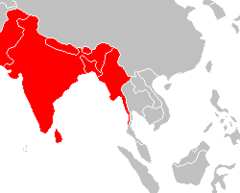Swamp barb
| Swamp barb | |
|---|---|
| Conservation status | |
| Scientific classification | |
| Kingdom: | Animalia |
| Phylum: | Chordata |
| Class: | Actinopterygii |
| Order: | Cypriniformes |
| Family: | Cyprinidae |
| Genus: | Puntius |
| Species: | P. chola |
| Binomial name | |
| Puntius chola (F. Hamilton, 1822) | |
 | |
| Nations where Puntius chola can be found | |
| Synonyms | |
|
Cyprinus chola (Hamilton, 1822) | |
The swamp barb or chola barb, Puntius chola, is a tropical freshwater fish belonging to the Cyprininae sub-family of the (Cyprinidae) family. It originates in inland waters in Asia, and is found in Pakistan, India, Nepal, Bangladesh, Sri Lanka, Bhutan, and Myanmar.
Physical description
The fish will grow in length up to 6 inches (15 centimeters) and weigh up to 60 grams (2.1 ounces).
Habitat
It natively inhabits streams, rivers, canals, mangroves, marshes, swamps, ponds, and inundated fields, mainly in shallow water. They live in a tropical climate in water with a 6.0 - 6.5 pH, a water hardness of 8 - 15 dGH, and a temperature range of 68–77 °F (20–25 °C). It feeds on worms, benthic crustaceans, insects, and plant matter.
Importance to humans
The swamp barb is of commercial importance in the aquarium trade and the fisheries industry.
Breeding
The swamp barb is an open water, substrate egg-scatterer, and adults do not guard the eggs.
During breeding time, the males display very prominent red bands, which lasts for around two days (rivaling Rosy Barbs - P conchonius), while females display red stripes which last around 5 hours.
See: http://www.ias.ac.in/currsci/apr102008/922.pdf for colour photos of P chola in courtship.
Name origins
The swamp barb was originally named Cyprinus chola by Dr. Francis Buchanan-Hamilton in 1822, and has also been referred to in scientific literature as Puntius titius, Barbus chola, Capoeta chola, or Barbus titius.In Bengali:পুঁটি
